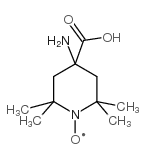Conformational properties of angiotensin II and its active and inactive TOAC-labeled analogs in the presence of micelles. Electron paramagnetic resonance, fluorescence, and circular dichroism studies.
Renata F F Vieira, Fábio Casallanovo, Nélida Marín, Antonio C M Paiva, Shirley Schreier, Clóvis R Nakaie
Index: Biopolymers 92(6) , 525-37, (2009)
Full Text: HTML
Abstract
The interaction between angiotensin II (AII, DRVYIHPF) and its analogs carrying 2,2,6,6-tetramethylpiperidine-1-oxyl-4-amino-4-carboxylic acid (TOAC) and detergents--negatively charged sodium dodecyl sulfate (SDS) and zwitterionic N-hexadecyl-N,N-dimethyl-3-ammonio-1-propanesulfonate (HPS)--was examined by means of EPR, CD, and fluorescence. EPR spectra of partially active TOAC1-AII and inactive TOAC3-AII in aqueous solution indicated fast tumbling, the freedom of motion being greater at the N-terminus. Line broadening occurred upon interaction with micelles. Below SDS critical micelle concentration, broader lines indicated complex formation with tighter molecular packing than in micelles. Small changes in hyperfine splittings evinced TOAC location at the micelle-water interface. The interaction with anionic micelles was more effective than with zwitterionic micelles. Peptide-micelle interaction caused fluorescence increase. The TOAC-promoted intramolecular fluorescence quenching was more pronounced for TOAC3-AII because of the proximity between the nitroxide and Tyr4. CD spectra showed that although both AII and TOAC1-AII presented flexible conformations in water, TOAC3-AII displayed conformational restriction because of the TOAC-imposed bend (Schreier et al., Biopolymers 2004, 74, 389). In HPS, conformational changes were observed for the labeled peptides at neutral and basic pH. In SDS, all peptides underwent pH-dependent conformational changes. Although the spectra suggested similar folds for AII and TOAC1-AII, different conformations were acquired by TOAC3-AII. The membrane environment has been hypothesized to shift conformational equilibria so as to stabilize the receptor-bound conformation of ligands. The fact that TOAC3-AII is unable to acquire conformations similar to those of native AII and partially active TOAC1-AII is probably the explanation for its lack of biological activity.Copyright 2009 Wiley Periodicals, Inc.
Related Compounds
| Structure | Name/CAS No. | Molecular Formula | Articles |
|---|---|---|---|
 |
TOAC
CAS:15871-57-5 |
C10H19N2O3 |
|
In silico interpretation of cw-ESR at 9 and 95 GHz of mono- ...
2011-11-10 [J. Phys. Chem. B 115(44) , 13026-36, (2011)] |
|
Intramembrane water associated with TOAC spin-labeled alamet...
2009-02-01 [Biophys. J. 96(3) , 997-1007, (2009)] |
|
Probing the helical tilt and dynamic properties of membrane-...
2012-03-01 [Biochim. Biophys. Acta 1818(3) , 645-50, (2012)] |
|
Membrane interaction of neuropeptide Y detected by EPR and N...
2005-08-15 [Biochim. Biophys. Acta 1714(2) , 103-13, (2005)] |
|
Electron paramagnetic resonance studies of an integral membr...
2006-09-20 [J. Am. Chem. Soc. 128(37) , 12070-1, (2006)] |